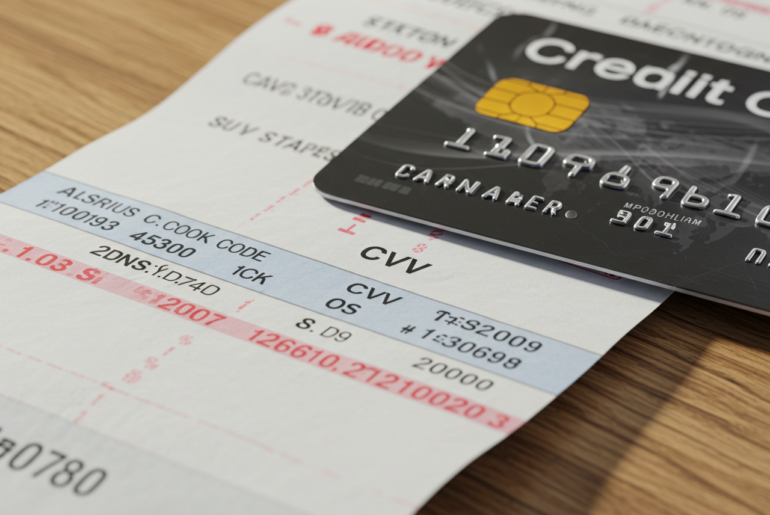This article may contain references to products or services from one or more of our advertisers or partners. We may receive compensation when you click on links to those products or services. Nonetheless, our opinions are our own.
The information presented in this article is accurate to the best of our knowledge at the time of publication. However, information is subject to change, and no guarantees are made about the continued accuracy or completeness of this content after its publication date.
- Key Highlights
- Introduction
- Understanding AVS and CVV in Digital Payments
- What Is AVS (Address Verification Service)?
- What Is CVV (Card Verification Value)?
- How to Implement AVS and CVV
- Step-by-Step Guide to Integration
- Comparison Table
- Setting Up AVS with Your Payment System
- Configuring CVV Settings for Better Security
- Conclusion
- Frequently Asked Questions
- Recommended Reads
Key Highlights
- AVS and CVV help see who is using the card and reduce online credit card fraud.
- AVS checks the billing address you enter at checkout and matches it with the card issuer’s address.
- CVV is a credit card code showing the buyer has the card with them.
- These tools make online payments safer for both businesses and customers.
- Understanding how AVS and CVV work helps businesses build better systems to stop fraud.
Introduction
As digital payments grow in popularity, safe transactions are significant. Tools like address checking and card security code help stop fraud. Understanding how these tools work together can help businesses and people protect their money and personal information.
Understanding AVS and CVV in Digital Payments
Trust and security are crucial for online payments. As more people buy things online, both businesses and customers need to protect their private money information. Two main tools for this are AVS and CVV. While they are often mentioned at the same time, they serve different purposes.
AVS checks if the billing address you provide when buying an item matches the address linked to your card issuer. CVV, however, ensures that the person purchasing the item actually has the credit card on them.
What Is AVS (Address Verification Service)?
Address Verification Service (AVS) reduces fraud in online transactions by checking parts of the billing address, such as the street number and ZIP code, against the information from the card issuer. Based on how well these match, AVS gives a response code. This code shows if the address you gave is correct.
Merchants can use this response to approve, mark, or decline a transaction, making AVS useful for detecting unauthorized purchases.
What Is CVV (Card Verification Value)?
CVV stands for Card Verification Value. It is a code made up of three or four numbers. You can see it printed on the back or front of a credit or debit card. This code is not stored in the card’s magnetic strip, which makes it useful for keeping your card safe during “card-not-present” transactions, which happen when you shop online or order by phone.
CVV checks help confirm that the buyer has the real card when they purchase. If the CVV does not match, the store may decline the transaction or take a closer look at it. This varies based on how the store has set up its fraud rules.
Voted "Best Overall Budgeting App" by Forbes and WSJ
Monarch Money helps you budget, track spending, set goals, and plan your financial future—all in one app.
Get 50% OFF your first year with code MONARCHVIP
How to Implement AVS and CVV
Getting Started with AVS and CVV
Adding AVS and CVV to your online business is simple. Most payment processors include these tools in their security features. To make the most of them:
- Pick a payment processor that has AVS and CVV.
- Activate AVS and CVV checks in your payment gateway settings.
- Train your staff on how these tools work and what steps to take if there are mismatches.
- Stay updated on changes in fraud trends and the best ways to keep secure.
Once these tools are turned on, they run automatically in the background to check transactions. They provide safety without making the checkout process harder.
Step-by-Step Guide to Integration
Step 1: Work with a Payment Gateway
Pick a payment gateway that supports AVS and CVV checks. Most modern platforms have these options.
Step 2: Configure Your Settings
In your payment gateway dashboard, find the security or fraud protection section. From there, you can turn on AVS and CVV checks. Some gateways allow you to create your own rules for these checks. For instance, you can accept transactions that match only part of the address.
Step 3: Update Your Checkout Page
Ensure your online checkout form has a place for the billing address and a spot for the CVV. Without these, you cannot finish the check.
By following these steps, your business can spot fraud attempts quickly. This will help you build more trust with your customers.
Comparison Table
| Feature | What It Does |
|---|---|
| AVS | Verifies the billing address with the card issuer to check for mismatches. |
| CVV | Confirms the cardholder has the physical card by validating the security code. |
Setting Up AVS with Your Payment System
To turn on AVS, log into your payment gateway dashboard. Find the section that discusses fraud safety. Turn on AVS, then select how strict you want it to be when checking billing addresses. Some providers allow partial matches, but others require exact matches.
AVS works behind the scenes. It sends billing details to the card issuer for verification. Based on the AVS code it receives, your system can either approve the transaction or flag it for review.
Configuring CVV Settings for Better Security
Turning on CVV check is usually simple. You must only click a box in your payment system’s safety settings. Some systems allow you to pick what to do if the codes do not match. You can either deny the transaction or send it for a manual review.
Remember, CVV is only valid for transactions without a card. By using this tool, your business can reduce the chances of handling fake orders.
Conclusion
AVS and CVV are essential tools for keeping online payments safe today. No single tool can entirely prevent fraud on its own. But when you use both together, it dramatically reduces the risk. For any business that accepts online payments, turning on AVS and CVV is an innovative and simple way to make transactions more secure.
Frequently Asked Questions
What is the main distinction between AVS and CVV?
AVS checks to ensure the billing address you enter at checkout matches the card issuer’s records. CVV verifies that the buyer truly has the card by requesting the security code printed on the card.
How do AVS and CVV improve transaction security?
AVS helps prevent fake purchases with stolen card details by checking the billing address. CVV ensures that the person buying has the real card, creating another layer of security against unauthorized use.
Does the law require AVS and CVV checks?
No, AVS and CVV checks are not required by law. However, using them is a wise choice. They are common steps to prevent fraud. Most payment processors offer these tools automatically. They help reduce chargebacks and keep stores and customers safe from unauthorized transactions.
Can AVS or CVV checks cause real transactions to be denied?
Sometimes, real transactions can be declined if the address or CVV code is mistyped. Customers might mistype their billing ZIP code or enter the wrong security code. That is why businesses need to balance strong security rules with a simple user experience.

Reviewed and edited by Albert Fang.
See a typo or want to suggest an edit/revision to the content? Use the contact us form to provide feedback.
At FangWallet, we value editorial integrity and open collaboration in curating quality content for readers to enjoy. Much appreciated for the assist.
Did you like our article and find it insightful? We encourage sharing the article link with family and friends to benefit as well - better yet, sharing on social media. Thank you for the support! 🍉
Article Title: AVS vs. CVV Codes: What’s the Difference?
https://fangwallet.com/2025/04/15/avs-vs-cvv-codes/The FangWallet Promise
FangWallet is an editorially independent resource - founded on breaking down challenging financial concepts for anyone to understand since 2014. While we adhere to editorial integrity, note that this post may contain references to products from our partners.
The FangWallet promise is always to have your best interest in mind and be transparent and honest about the financial picture.
Become an Insider

Subscribe to get a free daily budget planner printable to help get your money on track!
Make passive money the right way. No spam.
Editorial Disclaimer: The editorial content on this page is not provided by any of the companies mentioned. The opinions expressed here are the author's alone.
The content of this website is for informational purposes only and does not represent investment advice, or an offer or solicitation to buy or sell any security, investment, or product. Investors are encouraged to do their own due diligence, and, if necessary, consult professional advising before making any investment decisions. Investing involves a high degree of risk, and financial losses may occur including the potential loss of principal.
Source Citation References:
+ Inspo
There are no additional citations or references to note for this article at this time.












































